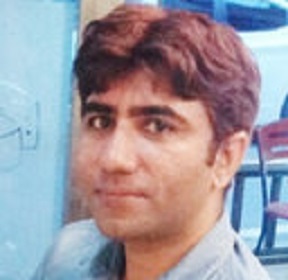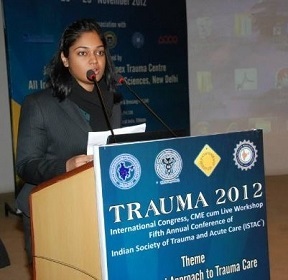Speakers
Mirza Muhammad Faran Ashraf Baig
The University of Hong Kong Hong kongTitle: 2D DNA nanoporous scaffold promotes osteogenic differentiation of pre-osteoblasts
Abstract:
Biofunctional materials with nanomechanical parameters similar to bone tissue may promote the adherence, migration, proliferation, and differentiation of pre-osteoblasts. In this study, deoxyribonucleic acid (DNA) nanoporous scaffold (DNA-NPS) was synthesized by the polymerization of rectangular and double-crossover (DX) DNA tiles. The diagonally precise polymerization of nanometer-sized DNA tiles (A + B) through sticky end cohesion gave rise to a micrometer-sized porous giant-sheet material. The synthesized DNA-NPS exhibited a uniformly distributed porosity with a size of 25 ± 20 nm. The morphology, dimensions, sectional profiles, 2-dimensional (2D) layer height, texture, topology, pore size, and mechanical parameters of DNA-NPS have been characterized by atomic force microscopy (AFM). The size and zeta potential of DNA-NPS have been characterized by the zeta sizer. Cell biocompatibility, proliferation, and apoptosis have been evaluated by flow cytometry. The AFM results confirmed that the fabricated DNA-NPS was interconnected and uniformly porous, with a surface roughness of 0.125 ± 0.08035 nm. The elastic modulus of the DNA-NPS was 22.45 ± 8.65 GPa, which was comparable to that of native bone tissue. DNA-NPS facilitated pre-osteoblast adhesion, proliferation, and osteogenic differentiation. These findings indicated the potential of 2D DNA-NPS in promoting bone tissue regeneration.
Biography:
Baig, MMFA is a registered Pharmacist and did a PhD in Chemistry. His recent research interest is designing nanomaterials for Biomedical Engineering, Mechano Pharmacology, Developmental Biology, Structural Biology,and Neuroscience. He got his post-doctoral training in Nanomedicine at the Faculty of Dentistry, The University of Hong Kong. His postdoctoral work was focused on designing DNA-based functional & bio-active nanomaterials to apply in Restorative Dentistry, Oral Microbiology/ Oncology,Regenerative Therapeutics, Stem Cells Research, Drug Delivery, and Molecular Pharmaceutics. He got a Ph.D. degree in Chemistry (Therapeutical Biochemistry) from the School of Chemistry and Chemical Engineering, Nanjing University (NJU), China. During his Ph.D., he worked on DNA Nanotechnology, Nano-Therapeutics, Biosensing, Bio-imaging, Diagnostics, and Cellular Biophysics. Previously, He received his Doctor of Pharmacy (PharmD) and MPhil (Pharmaceutical Chemistry) degrees from the Faculty of Pharmacy, Bahauddin Zakariya University (BZU), Multan, Pakistan; where he learned about Biochemistry, Phytochemistry, Pharmacognosy, Biotechnology, Polymers, Organic, Medicinal, Bio-analytical, and Material Chemistry.
Nadeem Qaiser
King Abdullah University of Science and Technology KSATitle: Advanced Micro/Nanofluidic Devices and Their Novel Applications
Abstract:
About "Advanced Micro/Nanofluidic Devices and Their Novel Applications"
Shruti Dabi
Rajasthan University of Health Science IndiaTitle: Comparative evaluation of role of Oro-t mouthwash and Smf mouthwash as adjunct to scaling (subgingival irrigation): A randomized clinico-comparative study
Abstract:
Background: Molecular characterization of breast cancer heterogeneity facilitates the understanding of disease etiology and progression. More specifically, mutations in known and tumor suppressor genes such as BRCA1, BRCA2 and TP53, result in the alteration of a genomic landscape within sporadic and familial breast cancers. Single nucleotide polymorphisms (SNPs) are described as a mutation with a particular prevalence in certain ethinic population that in turn result in the altered prevalence of disease, the tumor suppressor genes responsible for maintaining the genomic stability. Certain SNPs in BRCA1, BRCA2 and TP53 are known to correlate with elevated risk of breast cancer development worldwide, however there is no such study categorizing the risk of breast cancer development in the Khyber Pakhtunkhwa population in Pakistan.
Objectives: We investigated known associative SNPs on the following risk alleles, BRCA1 (rs1799950), BRCA2 (rs144848) and TP53 (rs1042522) to determine the prevalence of these genetic elements within the Pakhtunkhwa population, and to further stratify the risk of breast cancer risk development conferred by such polymorphisms in the same population.
Methods: To determine the prevalence of known breast cancer associated SNPs, a total of 220 DNA samples were collected via venipuncture procedure. Out of 220, 140 of the samples were obtained from breast cancer patients and 80 were considered age and gender matched healthy controls. Genomic DNA was extracted from the peripheral blood cells and genotyping was performed utilizing a T-ARMS PCR technique. The frequencies of the polymorphisms were checked using SPSS version 16.
Results: Our results indicated that risk alleles of all three selected SNPs showed statistically significant association with breast cancer presence, p<0.05 (BRCA1, C- p=0.001); (BRCA2, C- p=0.000) and (TP53, C- p=0.000). Similarly, all the genotypes carrying risk allele were also significantly associated with the breast cancer risk with p<0.05 (BRCA1, TC- p=0.037, CC- p=0.005); (BRCA2, AC- p=0.000, CC- p=0.000) and (TP53, GC- p=0.000, CC- p=0.000).
Conclusion: The risk allele and risk allele containing genotypes showed statistically significant association with breast cancer risk in our region. More investigation will be required to disseminate the results with large data sets and using whole genome sequencing.
Key words: Breast cancer risk, BRCA1, BRCA2, TP53, Polymorphisms
Biography:
Najeeb Ullah Khan from Pakistan. he have a Ph.D. in Biochemistry and Molecular Biology. Recently, he is working on human genetic variability and susceptibility to cancer. His focus is to find the most associated gene polymorphism with cancer risk in our region and check the potential of that particular gene polymorphism as a biomarker for disease monitoring, especially cancer early diagnosis, particularly breast cancer. So far, we have confirmed the association of BRCA1&2, TP53, RANKL, OPG, IL-6, HER2 etc) polymorphisms with breast cancer risk in our population (Pashtun ethnicity). Several other related studies are under process in breast and other cancer including the association of noncoding RNA (microRNAs) with cancer risk. Interested in any kind of research collaboration in the field of cancer Biology, cancer genetics and cancer early diagnosis.
Taherah Mohammadabadi
Agricultural Sciences and Natural Resources University IranTitle: Nutraceutical Supplements for Diabetes and Its Complications
Abstract:
Diabetes mellitus is linked with cardiovascular diseases and kidney and liver failures. Although the proper treatment of diabetes includes insulin injection continuously to maintain blood glucose, but nowadays, the researchers following some adjunct natural therapy for diabetes. Bioactive components of herbs and camel milk as nutraceutical supplements can be effective on diabetes and cardiovascular and liver failures. Ginger can directly increase glucose uptake that may be beneficial for type 1 and type 2 diabetes. Using cinnamon in type 2 diabetics for 40 days decreased the blood glucose and lipids of diabetic patients. It is proved that Fenugreek seeds lower blood glucose in diabetes patients by insulinotropic effects of alkaloids. Dietary supplementation of 10 g Fenugreek/day in diabetes cases decreased insulin resistance. Nettle increase insulin sensitivity in muscle and fat cells, thereby increasing glucose uptake into cells and subsequently lower blood sugar.
Biography:
Taherah Mohammadabadi finished her PhD in Iran and Australia and has been as a researcher at University of Queensland, Australia; she has attended and presented her works in different conferences in some countries. She is working as academic member, researcher and teacher since 11 years ago in Faculty of Animal Science and Food Technology, Agricultural Sciences and Natural Resources University, Iran. She has been as supervisor for 10 PhD students and more than 30 Msc students. She has over 200 published publications, conferences presentations, and scientific projects; Also, some books on phytochemicals and microbes, bioactive components in the livestock milk; milk lactoferrin and health, anti-diabetes properties of camel milk. She is member of the editorial board and reviewer of some international and national journals.
Najeeb Ullah Khan
The University of Agriculture, Khyber Pakhtunkhwa, Pakistan PakistanTitle: Significant association of BRCA1, BRCA2 and TP53 gene polymorphisms with breast cancer risk in Khyber Pakhtunkhwa, Pakistan
Abstract:
Background: Molecular characterization of breast cancer heterogeneity facilitates the understanding of disease etiology and progression. More specifically, mutations in known and tumor suppressor genes such as BRCA1, BRCA2 and TP53, result in the alteration of a genomic landscape within sporadic and familial breast cancers. Single nucleotide polymorphisms (SNPs) are described as a mutation with a particular prevalence in certain ethinic population that in turn result in the altered prevalence of disease, the tumor suppressor genes responsible for maintaining the genomic stability. Certain SNPs in BRCA1, BRCA2 and TP53 are known to correlate with elevated risk of breast cancer development worldwide, however there is no such study categorizing the risk of breast cancer development in the Khyber Pakhtunkhwa population in Pakistan.
Objectives: We investigated known associative SNPs on the following risk alleles, BRCA1 (rs1799950), BRCA2 (rs144848) and TP53 (rs1042522) to determine the prevalence of these genetic elements within the Pakhtunkhwa population, and to further stratify the risk of breast cancer risk development conferred by such polymorphisms in the same population.
Methods: To determine the prevalence of known breast cancer associated SNPs, a total of 220 DNA samples were collected via venipuncture procedure. Out of 220, 140 of the samples were obtained from breast cancer patients and 80 were considered age and gender matched healthy controls. Genomic DNA was extracted from the peripheral blood cells and genotyping was performed utilizing a T-ARMS PCR technique. The frequencies of the polymorphisms were checked using SPSS version 16.
Results: Our results indicated that risk alleles of all three selected SNPs showed statistically significant association with breast cancer presence, p<0.05 (BRCA1, C- p=0.001); (BRCA2, C- p=0.000) and (TP53, C- p=0.000). Similarly, all the genotypes carrying risk allele were also significantly associated with the breast cancer risk with p<0.05 (BRCA1, TC- p=0.037, CC- p=0.005); (BRCA2, AC- p=0.000, CC- p=0.000) and (TP53, GC- p=0.000, CC- p=0.000).
Conclusion: The risk allele and risk allele containing genotypes showed statistically significant association with breast cancer risk in our region. More investigation will be required to disseminate the results with large data sets and using whole genome sequencing.
Key words: Breast cancer risk, BRCA1, BRCA2, TP53, Polymorphisms
Biography:
Najeeb Ullah Khan from Pakistan. He have a Ph.D. in Biochemistry and Molecular Biology. Recently, He is working on human genetic variability and susceptibility to cancer. My focus is to find the most associated gene polymorphism with cancer risk in our region and check the potential of that particular gene polymorphism as a biomarker for disease monitoring, especially cancer early diagnosis, particularly breast cancer. So far, confirmed the association of BRCA1&2, TP53, RANKL, OPG, IL-6, HER2 etc) polymorphisms with breast cancer risk in our population (Pashtun ethnicity). Several other related studies are under process in breast and other cancer including the association of noncoding RNA (microRNAs) with cancer risk. Interested in any kind of research collaboration in the field of cancer Biology, cancer genetics and cancer early diagnosis.
Jimmy Nkaiwuatei
Jomo Kenyatta University of Agriculture and Technology (JKUAT), Kenya KenyaTitle: The use of genetic interference mechanisms in treatment of human genetic disorders
Abstract:
Gene interference can be defined as the alteration of the activity of specific genes by altering the regulatory sequences. Gene therapy aims at treating genetic diseases through insertion and expression of specific exogenous genetic materials by transfer of nucleic acids either in vivo or in vitro (through modified cells). This results to expression of a normal product thus correcting the abnormal cellular function. Gene therapy involves two approaches which include germ-line and somatic line gene therapy. In germ-line gene therapy, the germ cells are integrated by exogenous functional genes which can be transferred into the offspring’s while in somatic line gene therapy, the genes are introduced into the patients’ somatic cells and the effects are only experienced on that particular individual. Both methods leads to reduction in the coding mRNA levels. RNA interference not only inhibits transcription, but also induces an RNA degradation process. Gene silencing is enhanced by presence of double stranded RNA (dsRNA) molecules and is initiated by the dicer enzyme, where the dsRNA are cleaved by the protein into small interfering RNA (siRNA) strands which can prime the mRNA of the coding genes to form a duplex (siRNA + mRNA). The duplex activates the RNA-induced silencing complex (RISC) which upon activation degrades the duplex with the critical coding sequences. This is very essential in gene silencing. This gene degradation mechanism thus blocks the process of translation thus inhibiting expression of abnormal proteins responsible for the genetic diseases.
Biography:
Jimmy Nkaiwuatei holds a Bachelor of Science in Biochemistry and Molecular Biology from Jomo Kenyatta University of Agriculture and Technology (JKUAT), Kenya. He is the founding Partner, Find Your Voice Science club and currently the head of Drug Research, Discovery and Innovations Program at Students against Superbugs Africa. He is also a member of Young African Leaders Initiative (YALI).
Poster
Wei Liu
Eindhoven University of Technology, Netherlands NetherlandsTitle: Numerically study the combined effect of electrophoresis and electroosmosis in the nonpolar system
Abstract:
Electrophoresis (EP) is the movement of the charged particles relative to a stationary liquid induced by an applied electric field. Electroosmosis (EO), on the other hand, is the movement of a liquid relative to a stationary charged surface caused by an external electric field. In nonpolar systems, charges are generated in the form of charged inverse micelles (CIMs). The addition of surfactants helps disperse particles in nonpolar systems and makes it possible for EP and EO to take place. The novelty of this work is in using numerical ways to uncover the physics behind the experimental fluid motion and particle trajectories in nonpolar systems, which may help people understand, control, and optimize the switching ability of microfluidic devices, especially electronic paper displays based on micro or nano-particles. A detailed 2D model is proposed to numerically study the combination of EP and EO in nonpolar solvents. In this model, the electroosmotic boundary condition is utilized to investigate the influence of the zeta potential. What’s more, to fully uncover the physics and chemistry in nonpolar systems, the surface reaction, which describes how IMs generate at the liquid-solid interface, is implemented. The interdigitated electrodes are shown (see Fig 1). In this model, the Navier-Stokes equation, Nernst-Planck equation, and Poisson equation are coupled together to solve the fluid motion and particle trajectories. The results of the simulation and experiment are firstly compared to validate the numerical model (see Fig 2), the analytic particle velocity is calculated by adding the fluid velocity produced by the numerical model to the electrophoretic particle velocity. Comparable results between simulations and experiments imply the accuracy of this model. To compare the particle trajectories, 50 particles are released in the numerical model, feeling the electric force and drag force, and move from random positions to the positive electrode (particles are negatively charged). The experimental and simulated particle trajectories are similar (see Fig 3a and b) which proves that the EP and EO contribute to the particle motion at the same time. To further validate this hypothesis, we separate the influence of EP and EO in a simple model, in which pure EP is implemented only. Particle trajectories follow the electric field lines (see Fig 3c). Comparing that with the experimental particle trajectories makes it easy to distinguish the importance of EO. What’s more, a model without taking zeta potential into account is built to investigate the role of the zeta potential. The result (see Fig 3d) shows that particle velocities in the area between two electrodes are very small. This means EO near the glass surface (glass substrates are negatively charged) generated due to the zeta potential can explain why particles in experiments move against the field lines near the edge of the positive electrode as well (see Fig 2a). The comparison between experimental and numerical results implies that the practical particle motion is dominated by both EP and EO. The numerical results of pure EP and the model without zeta potential further prove that both electric field and fluid motion influence the particle trajectories, which emphasizes the important role of the zeta potential as well. This work may benefit the fundamental study of EP and EO in nonpolar systems and help develop fast-switching electrokinetic displays as well.
Ellen Bold
Technical University of Kaiserslautern, Germany GermanyTitle: Investigation of channels with perforated wall for external boundary layer control
Abstract:
In recent years liquid-infused surfaces (LISs) have become a heavily studied topic due to their broad application range such as self-cleaning, pressure stability and ultra-slippery properties in channel flow. LIS relies on a physiochemical surface coverage with a low viscosity fluid creating an intermediate layer between the flowing fluid and a channel’s surface. Depending on the properties of the infused liquid the LIS is characterized by an effective slip length as the frictional drag that slows down the fluid flow at microscales is reduced. During flow shear forces may cause the partial or complete removal of the infusion liquid layer canceling the desired drag reduction effect. This effect could not be avoided so far due to a missing external access to the infusion layer on the channel’s surface. The main purpose of this study is the development of a technique to achieve active control of the infusion layer. We suggest to partially remove the channel’s surface or replace it by a permeable porous layer to obtain external excess through this surface area by means of an external gas pressure or by refilling the infusion fluid through it. By forming menisci in those open surface areas, the flow condition at the channel’s surface may be affected. As a very first implementation of this concept, we have structured thin stainless-steel sheets by laser ablation to form parallel rectangular slits (see Figure left). These sheets are then installed as one wall of a rectangular channel with the orientation of slits in flow direction. During fluid flow over these sheets, menisci are formed across the open slits establishing a Cassie state. Meniscus stability is improved forming a nanostructure layer on the channel’s surface followed by the depositing of a CF-containing thin film to render the channel’s surface superhydrophobic. CFD-Simulations illustrate the velocity field within and in close proximity to the infusion layer, allowing the numerical characterization of properties such as effective slip-length and frictional drag as well as a comparison of experimental results (see Figure right). First experimental results on the investigation of the flow through such channels and the control of the flow conditions are presented.
Biography:
Ellen Bold received her diploma in 2021 from the Technical University of Kaiserslautern. Since 2021, she is PhD student in the working group “Physics and Technology of Nanostructures” at the Technical University of Kaiserslautern
Aparajita Kumar
Max hospital, India IndiaTitle: SUCCESSFUL THROMBOLYSIS BY LOW DOSE SLOW INTRAVENOUS ALTEPLASE INFUSION IN CRITICALLY ILL PATIENTS WITH STUCK PROSTHETIC MITRAL VALVE:A CASE STUDY
Abstract:
Prosthetic valve thrombosis(PVT) contributes to significant post valve replacement mortality and morbidity.Treatment guidelines are controversial,ranging from surgical intervention to thrombolysis.We report a case study of two challenging patients who presented in our hospital,known Rheumatic Heart Disease,Post Mitral Valve Replacement,with Acute Left ventricular failure in NYHA class IV and PVT,of which one had coagulopathy with grossly deranged INR.Both patients were put on intermittent non invasive ventilator and inotropic supports,and successfully thrombolysed with low dose slow intravenous Alteplase infusion given every 6 hours in discrete doses with monitoring of PT/INR and mitral valve gradients,resulting in remarkable clinical improvement .Their successful treatment shows that thrombolysis can be considered as an effective treatment modality in high risk surgery patients with stuck prosthetic mitral valve.
Biography:
Aparajita Kumar has completed Diploma Cardiology in 2015 from MS Ramaiah Narayana Hrudalaya, Bangalore,,and is an International Associate, American College of Cardiology.She has over 7 years experience in Cardiology having previouly worked in leading corporate hospitals,,and is presently working as Consultant Cardiology-Non interventional in Max Hospital Dehradun, India.She has attended several national and international conferences,and has been a presenter in International Trauma Conference.She had been awarded Second prize in National Young Genie Champion in Cardiology in 2016.She has a keen interest in research,and completed Research to Publication course by UCMS California and BMJ for designing clinical trials and scientific writing,and was awarded 200 CPD credits for the same.Her key interests are Preventive cardiology, echocardiography and hypertension.









